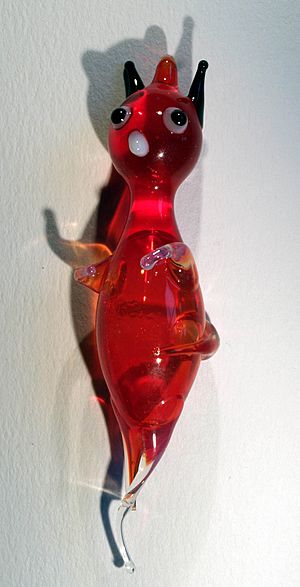Cartesian diver facts for kids
A Cartesian diver is a fun science toy. It is also called a Cartesian devil. This classic experiment shows how buoyancy (which is Archimedes' principle) and the ideal gas law work. Buoyancy is the upward push of a liquid or gas on an object. The ideal gas law describes how gases behave under different pressures and temperatures.
The first time this device was written about was in 1648. It was in a book by Raffaello Magiotti. The toy is named after René Descartes. People say he invented it.
You might see these toys called "water dancers" or "water devils." They work the same way. Instead of an eyedropper, they use a fancy glass object. This object is almost neutral in buoyancy. This means it almost floats and almost sinks. If the glass toy has a twisted tail, it can spin as it moves up and down. This happens because water flows in and out of it. The red "devil" in the picture is an example of such a toy.
This device can also be used in a practical way. It can help measure the pressure of a liquid. In the 1950s, plastic divers were given away in American cereal boxes. Later, in the 1980s, "Diving Tony" was a version of the toy. It looked like Tony the Tiger, the mascot for Kellogg's Frosted Flakes.
Contents
How the Experiment Works
The Cartesian diver experiment needs a large bottle filled with water. Inside the bottle is the "diver." This diver is usually a small, stiff tube, like an eyedropper. It is open at one end. There is just enough air inside it so that it is almost neutrally buoyant. This means it floats at the top, but it is almost completely underwater.
You can also make other types of divers. One can be a flexible bulb that is sealed. Another can be a sealed glass bulb with wool threads. The flexible one will squeeze and get smaller. The solid glass one won't change, but air bubbles will get caught in its threads. These bubbles will change size with pressure.
Making the Diver Sink
To make the diver sink, you press on the flexible part of the large container. This could be squeezing a plastic bottle. If it's a glass bottle, you might push the cork inwards. This action increases the pressure inside the container.
When the pressure goes up, it pushes on the water. This water then pushes on the air bubble inside the diver. Air can be squeezed (it's compressible), but water cannot. So, the air bubble gets smaller. More water then enters the diver.
Why the Diver Sinks and Floats
When the air bubble gets smaller and more water enters the diver, the diver becomes heavier. It now weighs more than the water it pushes aside. Because of this, it becomes negatively buoyant and sinks. This is explained by Archimedes' principle.
When you let go of the container, the pressure is released. The air inside the diver expands again. This pushes the water out of the diver. The diver then becomes lighter than the water it pushes aside. It becomes positively buoyant and floats back to the surface.
It is very hard to make the diver float in the middle of the container. If it moves up even a tiny bit, the pressure on its air bubble changes. This makes it float up even faster. If it moves down a tiny bit, the pressure increases. This makes it sink even faster. So, it usually either floats at the top or sinks to the bottom. To keep it in the middle, you would need to keep changing the pressure on the bottle.
Sometimes, divers in oval plastic bottles act differently. An oval bottle can actually get bigger in volume when squeezed. If this happens, a diver that has sunk can actually rise up again.
Images for kids
-
Hand blown glass toy from Lauscha, Thuringian Forest
See also
 In Spanish: Diablillo de Descartes para niños
In Spanish: Diablillo de Descartes para niños



